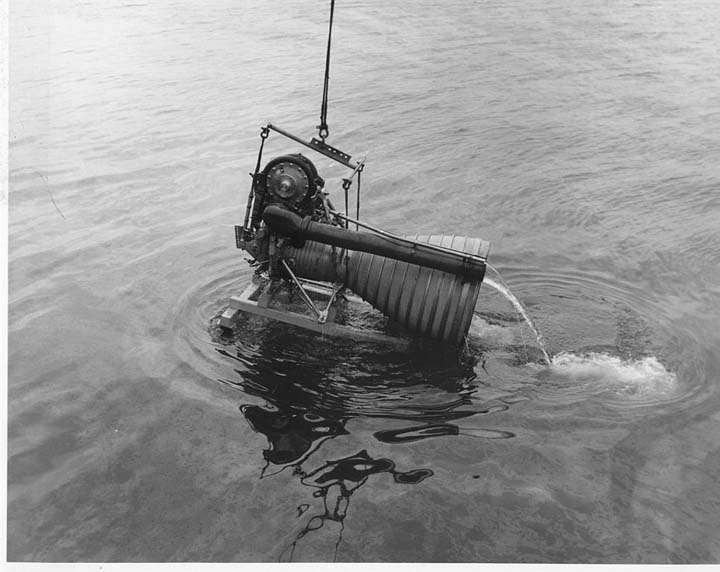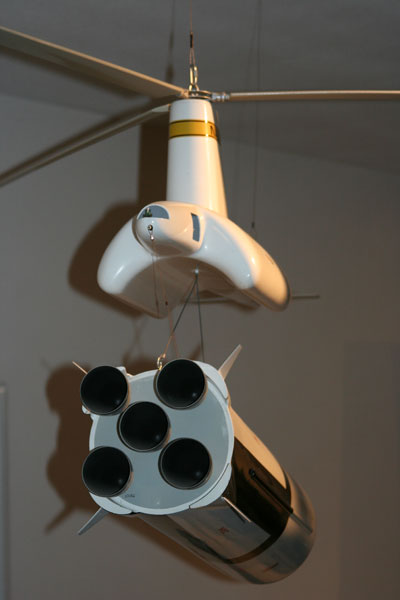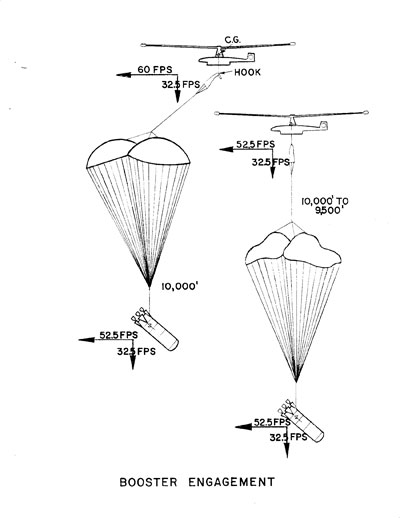Winston
Lorenzo von Matterhorn
- Joined
- Jan 31, 2009
- Messages
- 9,560
- Reaction score
- 1,748
The Saturn I: recoverable
https://forum.nasaspaceflight.com/index.php?topic=22659.0
The Saturn I, and its immediate predecessor the Juno V, were originally meant to have recoverable first stages. As with the Shuttle boosters, after separation the stage would plummet towards the ocean and finally pop chutes, splashing down to be towed back to shore by a ship. Unlike the Shuttle boosters, the Saturn booster would have a series of solid rocket motors near the base for terminal braking. As the Saturn descended under the chutes, a sensor would be dropped and would hang at the end of a long lanyard; when the sensor hit the water, the solid rockets would fire, slowing the booster just before impact.
The intent was not to make the Saturn first stage immediately reusable. The intent was to simply make it recoverable. It was fully expected that the booster would be largely trashed... but if you recover it, you can figure out what broke and how... and design a fix for that for the next launch. Eventually the Saturn would be recoverable in a condition where it could be used again, greatly lowering the cost of space launch. Remember, this was the late 1950's, when the military was looking towards doing a *lot* of space launches. The basic recovery philosophy seems to be similar to SpaceX's approach.
An ABMA cutaway from 1959 shows the parachute pack at the top, in the interstage region (higher rez here: https://up-ship.com/blog/?p=7030).
In support of this, testing was carried of where fired H-1 engines were immersed in salt water for extended periods, cleaned up and fired again... successfully (see: https://up-ship.com/blog/?p=5948 and https://up-ship.com/blog/?p=6012).
Artwork depicting the Juno V under chutes, preparing for splashdown: https://up-ship.com/blog/?p=5311
Art and diagrams for the recoverable Saturn I: https://up-ship.com/blog/?p=5527
Salt water test of H-1 engine:

[video=youtube;Vwh8hjjzAKs]https://www.youtube.com/watch?v=Vwh8hjjzAKs[/video]

Recovery and reuse of Saturn V's first stage; 18 page booklet by Boeing:
https://www.collectspace.com/ubb/Forum29/HTML/000880.html

Monster chopper
https://www.thespacereview.com/article/1045/1
...back in 1965 the company made a proposal so bold that it bordered on insane: a giant helicopter with a rotor diameter bigger than the length of a football field, capable not merely of transporting a Saturn 5 first stage, but of actually catching it in midair as it fell on a parachute. Strike thatit did not border on insane, it was insane. But those were heady days in the mid-1960s, a time when NASA was getting nearly five percent of the federal budgetten times more than todayand when the agency was doling out study contracts for everything from nuclear rockets to ion engines to 100-man space stations.
Hiller did not call their idea a helicopter, at least not on the title page. Instead they referred to it as a Rotary Wing System for Booster Recovery. In their proposal, Hiller noted that there were many concepts for Saturn first stage recovery, but that these all had drawbacks, including complexity, performance penalties, landing shock damage and/or seawater contamination. Hillers helicopter would recover the booster in its own elementi.e. in air. The helicopter could also be used as a crane or aerial transport for booster segments.
It would be a monster. The rotor diameter would be over 120 meters (400 feet). Empty weight would be over 200,000 kilograms (450,000 pounds), with a useful load of nearly 250,000 kilograms (550,000 pounds)for a gross weight of a whopping 453,000 kilograms (1,000,000 pounds).
The plan was for the helicopter to be capable of loitering in the recovery area for up to six hours, flying at an altitude of 4,5006,000 meters (15,00020,000 feet).
Upon sighting the booster, the helicopter would head for it and intercept it at approximately 3,000 meters (10,000 feet). The S-1Cs parachute system would be descending along a glide path with more forward than downward velocity. The helicopter would align with the glide path and approach from behind and above, descending to match trajectories with the booster. It would snag the pickup chute with a grappling hook suspended from the helicopters center of gravity and gradually assume the weight of the booster. The parachutes would be deflated and the booster suspended about 215 meters (700 feet) below the helicopter.
The helicopter would then reel-in the booster, rotating it to a horizontal position and snugging it up underneath the helicopterand then returning it to the launch area or some other destination on land. Of course, the S-1C stage would fall over 650 kilometers (350 nautical miles) from the launch site. How feasible was it for the worlds largest helicopter, carrying the worlds largest rocket, to fly this distance back home? What about wind? Although Hillers proposal did not say so, a far better solution would have been for the helicopter to set the stage down on a ship near the recovery area. Of course, it would have to be a big ship, like an aircraft carrier, or a barge. But nothing would be small with this concept.


Reusable Saturn V
https://forum.nasaspaceflight.com/index.php?topic=37052.0
There were *many* proposals for reusable Saturn Vs, specifically reusable S-IC stages. There were a number of manned, winged flyback boosters like the Boeing Models 922 and 979 (https://aerospaceprojectsreview.com/ev1n2.htm), and similar designs from McD and NAR; there were also designs for parachute recovered (via splashdown) as well as balloon-retarded versions (including hot-air versions meant to provide enough buoyancy to actually float in the air, good for recovery directly onto the deck of a ship).
Recoverable S-IB--Chrysler.pdf
https://forum.nasaspaceflight.com/index.php?action=dlattach;topic=37052.0;attach=824 208;sess=0
Saturn Paraglider Materials--Goodyear.pdf
https://forum.nasaspaceflight.com/index.php?action=dlattach;topic=37052.0;attach=824 216;sess=0
S-IC Recovery--Brown Eng..pdf
https://forum.nasaspaceflight.com/index.php?action=dlattach;topic=37052.0;attach=823 989;sess=0
SATURN ILLUSTRATED CHRONOLOGY
Saturn's First Eleven Years: April 1957 through April 1968
Text:
https://history.nasa.gov/MHR-5/contents.htm
Scan of original in PDF:
https://ntrs.nasa.gov/archive/nasa/casi.ntrs.nasa.gov/19740004382.pdf
https://forum.nasaspaceflight.com/index.php?topic=22659.0
The Saturn I, and its immediate predecessor the Juno V, were originally meant to have recoverable first stages. As with the Shuttle boosters, after separation the stage would plummet towards the ocean and finally pop chutes, splashing down to be towed back to shore by a ship. Unlike the Shuttle boosters, the Saturn booster would have a series of solid rocket motors near the base for terminal braking. As the Saturn descended under the chutes, a sensor would be dropped and would hang at the end of a long lanyard; when the sensor hit the water, the solid rockets would fire, slowing the booster just before impact.
The intent was not to make the Saturn first stage immediately reusable. The intent was to simply make it recoverable. It was fully expected that the booster would be largely trashed... but if you recover it, you can figure out what broke and how... and design a fix for that for the next launch. Eventually the Saturn would be recoverable in a condition where it could be used again, greatly lowering the cost of space launch. Remember, this was the late 1950's, when the military was looking towards doing a *lot* of space launches. The basic recovery philosophy seems to be similar to SpaceX's approach.
An ABMA cutaway from 1959 shows the parachute pack at the top, in the interstage region (higher rez here: https://up-ship.com/blog/?p=7030).
In support of this, testing was carried of where fired H-1 engines were immersed in salt water for extended periods, cleaned up and fired again... successfully (see: https://up-ship.com/blog/?p=5948 and https://up-ship.com/blog/?p=6012).
Artwork depicting the Juno V under chutes, preparing for splashdown: https://up-ship.com/blog/?p=5311
Art and diagrams for the recoverable Saturn I: https://up-ship.com/blog/?p=5527
Salt water test of H-1 engine:

[video=youtube;Vwh8hjjzAKs]https://www.youtube.com/watch?v=Vwh8hjjzAKs[/video]

Recovery and reuse of Saturn V's first stage; 18 page booklet by Boeing:
https://www.collectspace.com/ubb/Forum29/HTML/000880.html

Monster chopper
https://www.thespacereview.com/article/1045/1
...back in 1965 the company made a proposal so bold that it bordered on insane: a giant helicopter with a rotor diameter bigger than the length of a football field, capable not merely of transporting a Saturn 5 first stage, but of actually catching it in midair as it fell on a parachute. Strike thatit did not border on insane, it was insane. But those were heady days in the mid-1960s, a time when NASA was getting nearly five percent of the federal budgetten times more than todayand when the agency was doling out study contracts for everything from nuclear rockets to ion engines to 100-man space stations.
Hiller did not call their idea a helicopter, at least not on the title page. Instead they referred to it as a Rotary Wing System for Booster Recovery. In their proposal, Hiller noted that there were many concepts for Saturn first stage recovery, but that these all had drawbacks, including complexity, performance penalties, landing shock damage and/or seawater contamination. Hillers helicopter would recover the booster in its own elementi.e. in air. The helicopter could also be used as a crane or aerial transport for booster segments.
It would be a monster. The rotor diameter would be over 120 meters (400 feet). Empty weight would be over 200,000 kilograms (450,000 pounds), with a useful load of nearly 250,000 kilograms (550,000 pounds)for a gross weight of a whopping 453,000 kilograms (1,000,000 pounds).
The plan was for the helicopter to be capable of loitering in the recovery area for up to six hours, flying at an altitude of 4,5006,000 meters (15,00020,000 feet).
Upon sighting the booster, the helicopter would head for it and intercept it at approximately 3,000 meters (10,000 feet). The S-1Cs parachute system would be descending along a glide path with more forward than downward velocity. The helicopter would align with the glide path and approach from behind and above, descending to match trajectories with the booster. It would snag the pickup chute with a grappling hook suspended from the helicopters center of gravity and gradually assume the weight of the booster. The parachutes would be deflated and the booster suspended about 215 meters (700 feet) below the helicopter.
The helicopter would then reel-in the booster, rotating it to a horizontal position and snugging it up underneath the helicopterand then returning it to the launch area or some other destination on land. Of course, the S-1C stage would fall over 650 kilometers (350 nautical miles) from the launch site. How feasible was it for the worlds largest helicopter, carrying the worlds largest rocket, to fly this distance back home? What about wind? Although Hillers proposal did not say so, a far better solution would have been for the helicopter to set the stage down on a ship near the recovery area. Of course, it would have to be a big ship, like an aircraft carrier, or a barge. But nothing would be small with this concept.


Reusable Saturn V
https://forum.nasaspaceflight.com/index.php?topic=37052.0
There were *many* proposals for reusable Saturn Vs, specifically reusable S-IC stages. There were a number of manned, winged flyback boosters like the Boeing Models 922 and 979 (https://aerospaceprojectsreview.com/ev1n2.htm), and similar designs from McD and NAR; there were also designs for parachute recovered (via splashdown) as well as balloon-retarded versions (including hot-air versions meant to provide enough buoyancy to actually float in the air, good for recovery directly onto the deck of a ship).
Recoverable S-IB--Chrysler.pdf
https://forum.nasaspaceflight.com/index.php?action=dlattach;topic=37052.0;attach=824 208;sess=0
Saturn Paraglider Materials--Goodyear.pdf
https://forum.nasaspaceflight.com/index.php?action=dlattach;topic=37052.0;attach=824 216;sess=0
S-IC Recovery--Brown Eng..pdf
https://forum.nasaspaceflight.com/index.php?action=dlattach;topic=37052.0;attach=823 989;sess=0
SATURN ILLUSTRATED CHRONOLOGY
Saturn's First Eleven Years: April 1957 through April 1968
Text:
https://history.nasa.gov/MHR-5/contents.htm
Scan of original in PDF:
https://ntrs.nasa.gov/archive/nasa/casi.ntrs.nasa.gov/19740004382.pdf


